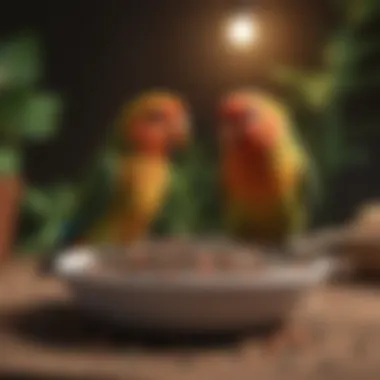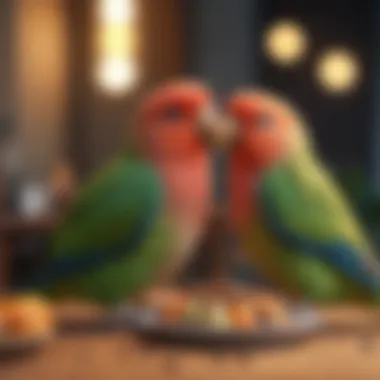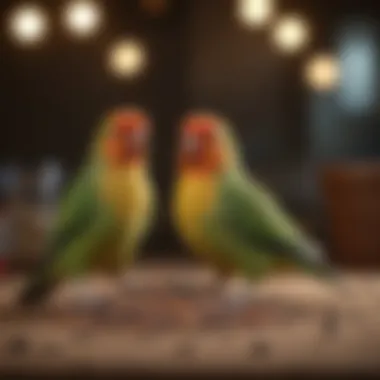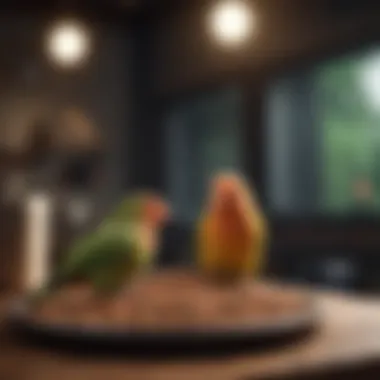Understanding Lovebird Pellet Food: A Comprehensive Guide


Intro
Lovebirds are small, vibrant parrots known for their playful nature and strong social bonds. They are a popular choice among pet owners due to their engaging personalities and affectionate demeanor. However, providing the right nutrition for these lively birds is crucial for their health and well-being. Among the various diets available, pellet food has gained significant attention, promising a balanced and complete meal option for lovebirds.
This guide will explore the various aspects of lovebird pellet food, including its nutritional needs and benefits, as well as how to effectively choose the right product for your feathered companions. Understanding the fundamentals of lovebird diets can help ensure that these delightful birds thrive in your care.
Understanding Your Pet
Pet Behavior Basics
Lovebirds exhibit a range of behaviors that reflect their social nature. They thrive on interaction and require stimulation to keep them mentally engaged. Observing their social cues can also inform you about their needs. For instance, a lovebird that is vocalizing or preening excessively may be indicating a need for companionship or something to occupy their time.
Common Breed Characteristics
Different breeds of lovebirds may have distinct characteristics. Some varieties, like the Peach-Faced Lovebird, tend to be more outgoing, while others like the Fischer's Lovebird may be slightly shy. Recognizing these traits can aid in tailoring their care, including their nutritional requirements.
Species-Specific Needs
Nutritional needs can vary among pet birds. Lovebirds, in particular, require a well-rounded diet to maintain their energy levels and overall health. Understanding these specific needs is essential for selecting appropriate food, especially when considering pellet options that are designed to cater to their unique dietary requirements.
Pet Care and Maintenance
Feeding Guidelines
When it comes to feeding lovebirds, a mix of pellet food and fresh produce can provide a well-balanced diet. Pellets should make up about 70-80% of their daily intake. Ensure that the pellets are specifically formulated for lovebirds to meet their nutritional needs. Products like Harrison’s Bird Foods and Zupreem are well-regarded among pet owners for their quality.
Grooming Essentials
Regular grooming is vital for maintaining a lovebird’s health. Provide opportunities for them to bathe, whether in a shallow dish or through gentle misting. Additionally, consider offering cuttlebone or mineral blocks for beak wear.
Hygiene Practices
Maintaining cleanliness in your bird's environment is critical. Regularly clean their cage, food and water dishes. Pay attention to any build-up that can create health risks. A clean space not only promotes health but also contributes to happy birds.
Health and Wellness
Routine Vet Check-ups
Routine veterinary visits are essential to monitor the health of lovebirds. A vet experienced in avian care can provide insights into dietary adjustments and other healthcare needs.
Vaccination Needs
Consult with your veterinarian about vaccination for common avian diseases. Keeping your lovebird up to date on vaccinations can prevent potential health issues.
Recognizing Signs of Illness
Being aware of behavioral changes can help detect illness early. Signs such as lethargy, changes in appetite, or abnormal droppings should prompt a visit to the vet. Early intervention can be crucial in addressing health issues.
Enrichment and Activities
Indoor vs.
Outdoor Activities
Both indoor and outdoor activities are essential for your lovebird's well-being. Indoor playstructures or gyms can provide entertainment, while safe outdoor time allows for natural foraging behaviors.


Interactive Toys and Games
Offering interactive toys is important to stimulate their intellect. Toys that encourage chewing and problem-solving can help prevent boredom and destructive behaviors. Consider toys made of safe materials, as lovebirds enjoy exploring.
Socialization Opportunities
Socialization is another critical aspect of lovebird care. They naturally thrive in the company of others, whether it be other birds or humans. Engaging them in daily interactions will foster their assertive and playful demeanor, enhancing both their happiness and well-being.
In summary, understanding the dietary and overall needs of lovebirds is essential for any pet owner. Ensure proper nutrition, social interaction, and health care to ensure a fulfilling life for your avian companions.
Prolusion to Lovebirds and Their Dietary Needs
Lovebirds are small, colorful parrots known for their affectionate nature and strong pair bonds. Understanding their dietary needs is crucial for ensuring their health and vitality. Proper nutrition plays a significant role in the overall well-being of lovebirds. A balanced diet not only supports their physical health but also contributes to their mental and emotional stability. In this context, pellet food has become a preferred choice among pet owners. This section explores the origin of lovebirds, their natural habitat, and the essential nutrients required for their diet.
Origin and Habitat
Lovebirds originate from the African continent, mainly from regions like Madagascar, Namibia, and South Africa. They thrive in subtropical and tropical climates, often found in woodland, savanna, and scrub habitats. These birds are social, usually living in flocks, which influences their feeding behavior. In the wild, lovebirds consume a wide range of seeds, fruits, and vegetables, adapting their diet according to the seasonal availability of food. This natural feeding pattern highlights the need for a diverse diet when they are kept as pets. Their habitat and foraging behavior are critical to understanding what constitutes a healthy diet for them.
Understanding Nutritional Requirements
Understanding the nutritional requirements of lovebirds is essential for every owner. These birds need a balanced diet that includes proteins, fats, vitamins, and minerals. In captivity, it is vital to mimic their natural diet as closely as possible. Here are key nutrients to consider:
- Proteins: Essential for growth, reproduction, and overall health. Good sources include pellets, seeds, and legumes.
- Fats: Provide energy and support cell function. Healthy fats can be found in seeds like sunflower and safflower.
- Vitamins: Important for immune function and vision. Fresh fruits and vegetables, along with fortified pellets, supply necessary vitamins.
- Minerals: Calcium, in particular, is crucial for bone health and egg production in females. Offer cuttlebone or mineral blocks as supplements.
A proper understanding of these dietary needs can lead to healthier, happier lovebirds. Recognizing the components of their diet is vital to ensuring they thrive in a domesticated environment.
What is Lovebird Pellet Food?
Understanding lovebird pellet food is essential for pet owners who want to provide a nutritious diet for their birds. This section will explore what lovebird pellets are, their composition, and various types available. Feeding lovebirds the right diet is vital for their overall health and well-being. Pellets can help ensure that lovebirds receive a balanced mix of nutrients that may not be found in other food options.
Definition and Composition
Lovebird pellet food refers to a specially formulated feed created for lovebirds containing a mixture of essential nutrients. Unlike seed mixes, which may lack balance, pellets come in uniform shape and size. Each pellet contains key vitamins, minerals, and proteins necessary for a lovebird's growth and health. Ingredients might include grains, seeds, legumes, vegetables, and additional supplements.
Common ingredients in lovebird pellets can consist of:
- Corn
- Wheat
- Oats
- Peas
- Vitamin and mineral additives
The design of the pellet helps in preventing selective feeding. This feeding behavior is common when offering seeds, as birds often pick their favorite seeds while avoiding others. Pellets aim to provide each lovebird with the right blend of nutrients needed for good health.
Types of Lovebird Pellets
Various types of lovebird pellets are available on the market. Understanding these options helps pet owners select the right food for their birds. Common types include:
- Low-Fat Pellets: Suitable for lovebirds that may be overweight or less active.
- Fortified Pellets: Enhanced with additional vitamins and minerals for added health benefits.
- Organic Pellets: Made from organic ingredients with no artificial additives or preservatives.
- Fruit-based Pellets: Include real fruit pieces for added flavor and natural sugars.
When selecting pellets, it is important to consider the specific dietary needs and preferences of your lovebird. This may mean trying different types or brands to find what works best for your feathered friend. Always consult with a veterinarian if unsure about the best dietary options.
Benefits of Pellets in a Lovebird's Diet
The use of pellets in a lovebird's diet is a widely recommended practice among avian specialists. This section focuses on the key benefits that pellets provide for lovebirds, addressing both nutritional and practical aspects that can enhance the feeding experience for both birds and their owners.
Nutritional Balance
Pellets are designed to offer a nutritionally balanced diet that meets the specific needs of lovebirds. Unlike seeds, which can be high in fat and low in certain vitamins, pellets provide a comprehensive mixture of nutrients essential for a lovebird's health.
Key Components of Nutritional Balance:


- Vitamins and Minerals: Pellets often contain added vitamins and minerals to ensure lovebirds receive all necessary nutrients.
- Quality Proteins: The composition often includes high-quality protein sources, supporting growth, repair, and overall vitality.
- Fiber Content: Adequate fiber in pellets aids in digestion, which is crucial for preventing gastrointestinal issues.
Pellets can be a primary source of nutrition that ensures lovebirds do not miss out on essential dietary components.
Convenience for Pet Owners
Choosing pellets simplifies the feeding routine for lovebird owners. Pellets eliminate the need for a complicated mix of different foods, making the management of a lovebird's diet more straightforward.
Advantages for Pet Owners:
- Easy Measurement: Pellets come in measured portions, reducing the risk of overfeeding.
- Minimal Preparation: Unlike fresh fruits and vegetables, pellets require no washing or cutting, providing a quick solution for busy owners.
- Less Mess: With pellets, there is often less seed hull waste compared to seeds, resulting in a cleaner feeding area.
This ease of use allows owners to focus on other aspects of pet care rather than spending time preparing meals.
Long Shelf-life and Freshness
Pellets typically offer a longer shelf-life compared to fresh produce or seed mixtures. The packaging of pellets is generally sealed and designed to maintain freshness, ensuring that your lovebirds always have access to wholesome food.
Benefits of Long Shelf-life:
- Less Waste: Owners can buy in bulk without worrying about quick spoilage. This also means lower overall costs.
- Consistency in Diet: Pellets provide consistent nutrition over time, allowing for more stable health outcomes for lovebirds.
- Storage Ease: Pellets are easy to store, taking up less space than a variety of fresh foods.
In summary, the inclusion of pellets in a lovebird's diet presents multiple advantages, from ensuring proper nutrition to making feeding routines efficient. These benefits underscore the role that pellets can play in promoting the health and well-being of lovebirds.
Comparing Pellets to Other Food Types
Understanding the differences between lovebird pellets and other food options is crucial for pet owners. These comparisons can help owners make informed decisions. Choosing the right diet directly affects the health and behavior of lovebirds. Seeds and fresh produce are common choices, but they come with their own set of benefits and drawbacks. Here, we will carefully examine how pellets stack up against seeds and fresh fruits or vegetables.
Seeds versus Pellets
Seeds are a traditional option for feeding birds, including lovebirds. Many owners prefer seeds due to their natural appearance and variety. However, seeds generally lack the complete nutrition that lovebirds require. They are often high in fat and low in essential vitamins and minerals. Over time, a seed-only diet can lead to nutritional deficiencies. This can manifest in health issues, such as feather plucking or obesity.
On the other hand, pellets are formulated to meet the specific nutritional needs of lovebirds. They contain a balanced mix of proteins, vitamins, and minerals. Pellets also reduce the risk of selective eating, which is common with seeds. Many lovebirds will pick and choose their favorite seeds while ignoring others.
The convenience of pellets is another benefit. They can be easily measured and stored. Here are some points to consider when comparing seeds to pellets:
- Nutrition: Pellets offer a balanced diet; seeds do not.
- Waste: Pellets create less mess than seeds, which can scatter.
- Longevity: Pellets generally have a longer shelf life, retaining freshness longer.
Selecting the Right Pellets for Lovebirds
Selecting the right pellets for lovebirds is essential for ensuring their health and well-being. Choosing an appropriate pellet can significantly affect their nutritional intake. A good diet contributes to their vibrant colors, energy levels, and overall mood. It's important to consider various factors when making this decision to optimize your lovebird's diet.
Factors to Consider
When selecting pellets for lovebirds, several factors come into play:
- Nutritional Needs: Different lovebirds have varying dietary requirements based on their age, activity level, and health condition. Selecting a pellet that meets these needs is crucial.
- Ingredients: The primary ingredients of the pellets should be high-quality and suitable for your bird. Look for a balanced mixture of grains, fruits, and vegetables, with minimal fillers.
- Size and Shape: Pellets should be the right size for lovebirds, as smaller birds can struggle to eat larger pellets. Ensure the shape is appropriate for their beak size.
- Brand Reputation: Some brands have established credibility in delivering high-quality bird food. It is wise to choose brands known for their commitment to pet health and nutrition.
Reading Ingredient Labels
Understanding how to read ingredient labels can help you make informed choices when buying lovebird pellets. Here are some key points to consider:
- First Ingredients Listed: Ingredients are usually listed in order of weight. The first few should be natural food sources, such as seeds or fruits.
- Avoid Fillers: Look out for fillers like corn or wheat. While these can be suitable in small amounts, they should not constitute the primary ingredient.
- Vitamins and Minerals: Check for added vitamins and minerals. Ensuring your lovebirds receive these nutrients is critical for maintaining their health.
Brand Recommendations


When it comes to brand recommendations, several companies are well-regarded in the lovebird community. Notable brands include:
- Harrison's Bird Foods: Known for its organic ingredients and high nutritional value.
- Kaytee: Offers a range of pellets specifically designed for parakeets and lovebirds with a good balance of nutrients.
- Zupreem: Provides a variety of pellet types, ensuring the right option based on specific dietary needs.
Choosing the right brand ensures better health and satisfaction for your lovebirds. Always read reviews and get feedback from other pet owners to find the best fit.
Selecting the right pellets lays the foundation for a healthy, balanced diet, which directly influences the happiness and longevity of your lovebirds.
Feeding Guidelines for Lovebird Pellets
Feeding guidelines are essential in ensuring that lovebirds receive the proper nutrition they require for optimal health. A well-structured feeding routine can lead to vibrant colors, active behaviors, and overall well-being. Understanding these guidelines helps pet owners make informed choices about their feathered companions, which is crucial in nurturing them effectively.
Age and Activity Considerations
Age and activity levels significantly influence how much food a lovebird requires. Younger lovebirds need more energy for growth and play. They often exhibit higher activity levels, thus requiring a nutrient-dense diet. Adult lovebirds, on the other hand, may have different energy needs based on their activity. A less active lovebird might not need as many pellets as a more energetic one. Since pellets are designed to provide balanced nutrition, adjusting the quantity based on these factors is critical.
It can be helpful to monitor their activity levels. For instance, a playful young lovebird may consume more pellets than an older one that prefers resting. Pet owners should aim to provide a baseline amount of pellets while remaining flexible regarding the specific needs of their lovebirds as their behaviors change with age.
Transitioning to Pellets
Transitioning lovebirds to pellet food requires a careful approach. Many bird owners notice their lovebirds favor seeds or other foods, making it essential to introduce pellets gradually. This transition period can take several days to weeks, but it is vital for the bird to accept its new diet.
Start by mixing a small portion of pellets with their regular seeds or favorite foods. Gradually increase the number of pellets while decreasing seeds. The aim is to ensure that lovebirds do not feel deprived. Providing a variety of pellet types can also help in this process, as it allows them to explore textures and flavors. Keep an eye on their response to the change, and be prepared to offer encouragement and reassurance throughout.
Monitoring Health and Behavior
Monitoring the health and behavior of lovebirds after changing their diet is crucial. Take note of changes in their eating habits, energy levels, and overall demeanor. Lovebirds may not show immediate signs of discomfort, but subtle changes can indicate issues related to diet.
Regular check-ups with a veterinarian can provide professional insights into dietary impacts on health. Additionally, keep track of their droppings. Healthy droppings are a good sign of proper nutrition. Being alert to any signs of distress or changes in behavior can help in adjusting their diet if necessary. Small changes in feeding habits can have significant effects on lovebirds, so a vigilant owner is essential for their well-being.
Remember, a balanced diet is key to a long and healthy life for your lovebird.
Common Misconceptions About Lovebird Pellets
Lovebird pellet food is often surrounded by myths and misunderstandings. Addressing these misconceptions is essential for pet owners. Many people have certain beliefs about these foods that can influence their feeding practices. Misconceptions can lead to improper dietary choices, which can harm a lovebird's health. This section clarifies these myths and presents factual information about lovebird pellets.
Understanding the Myths
A number of myths exist about lovebird pellets that can confuse pet owners. One common misconception is that all pellets are the same. Some may believe that any pellet food suffices. However, different brands and types can vary significantly in nutritional content. Not all pellets will meet the specific dietary needs of lovebirds. Therefore, owners must research the options available. Another prevalent myth suggests that lovebirds will not eat pellets. Many assume their feathered friends prefer seeds and won't switch to a pellet diet. Yet, many lovebirds can adapt to pellets with a gradual transition plan. It is crucial to offer a variety of foods to prevent boredom and encourage acceptance of pellets.
Debunking Food Preferences
Some pet owners believe that lovebirds have strict food preferences and will only consume certain items. This leads to the assumption that they will not eat pellets at all. In reality, lovebirds can be trained to accept pellets alongside their preferred foods. It's important to introduce pellets with patience. Many owners report success when combining seeds with pellets, gradually increasing the pellet ratio over time. This method can lead lovebirds to accept pellets more readily.
Moreover, it is also incorrect to think that fresh fruits and vegetables can exclusively replace the need for pellets. While these foods provide essential vitamins and minerals, they often lack the complete nutritional profile found in a well-formulated pellet. Therefore, balancing pellets with fresh produce is vital for a lovebird's health.
Key Point: Lovebirds can adapt their diets when introduced to new food gradually. They benefit from a combination of pellets, seeds, fruits, and vegetables for optimal health.
Final Thoughts on Lovebird Pellet Food
The conclusion of this article emphasizes the significance of understanding and utilizing lovebird pellet food in the dietary regimen of these vibrant birds. This section integrates key elements discussed throughout the text, outlining the benefits and considerations necessary for creating a healthful diet for lovebirds.
Creating a Balanced Diet
A balanced diet is essential for lovebirds to thrive. As discussed, lovebirds have specific nutritional requirements that must be met through a varied diet. Pellets can provide a significant foundation for these needs, but they should not solely define a lovebird's meals. Combining pellets with fresh fruits, vegetables, and occasional seeds creates a more comprehensive diet. This blend not only enhances nutrient intake but also adds texture and flavor, crucial for their well-being. When selecting fresh food, diversity is vital. For instance, introducing leafy greens, like kale or spinach, alongside fruits such as apples or berries, allows lovebirds to experience a range of tastes. Monitoring their reactions to new foods is also important, ensuring that they enjoy their meals while benefiting from essential nutrients.
Encouraging Healthy Eating Habits
Establishing a healthy eating routine is a process that requires attention and patience. Lovebirds naturally gravitate towards foods they enjoy, often leading them to prefer seeds over pellets if introduced together. Owners should be consistent in providing pellets daily, while gradually reducing the amount of seeds. It may take time for birds to accept pellets fully, but perseverance can significantly impact their long-term health.
Furthermore, it's beneficial to create an engaging feeding experience. This can be achieved by varying the presentation of pellets and fresh foods. For example, using a foraging toy can encourage exploration and play, making mealtime interactive. Regularly observing their eating habits ensures any issues are quickly addressed, allowing adjustments as necessary to promote a consistently healthy diet.
“Just like people, lovebirds thrive with a balanced approach to nutrition and a positive feeding environment.”







